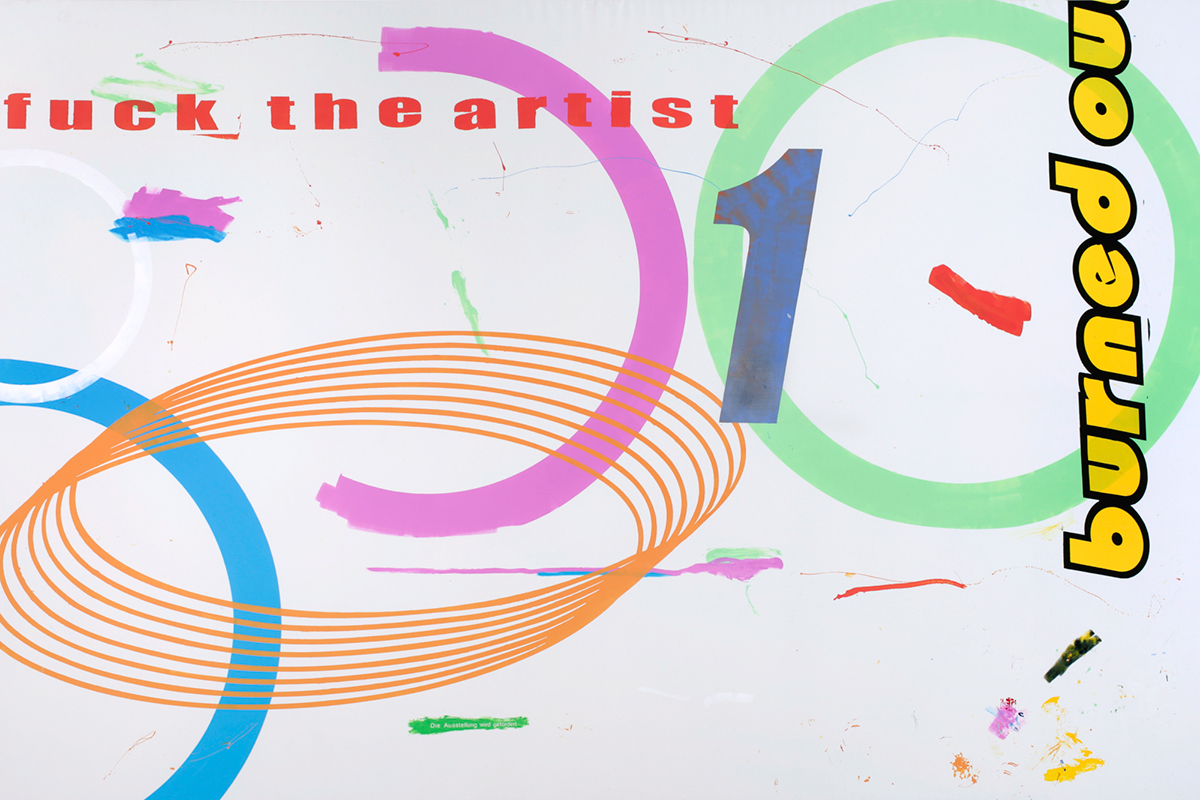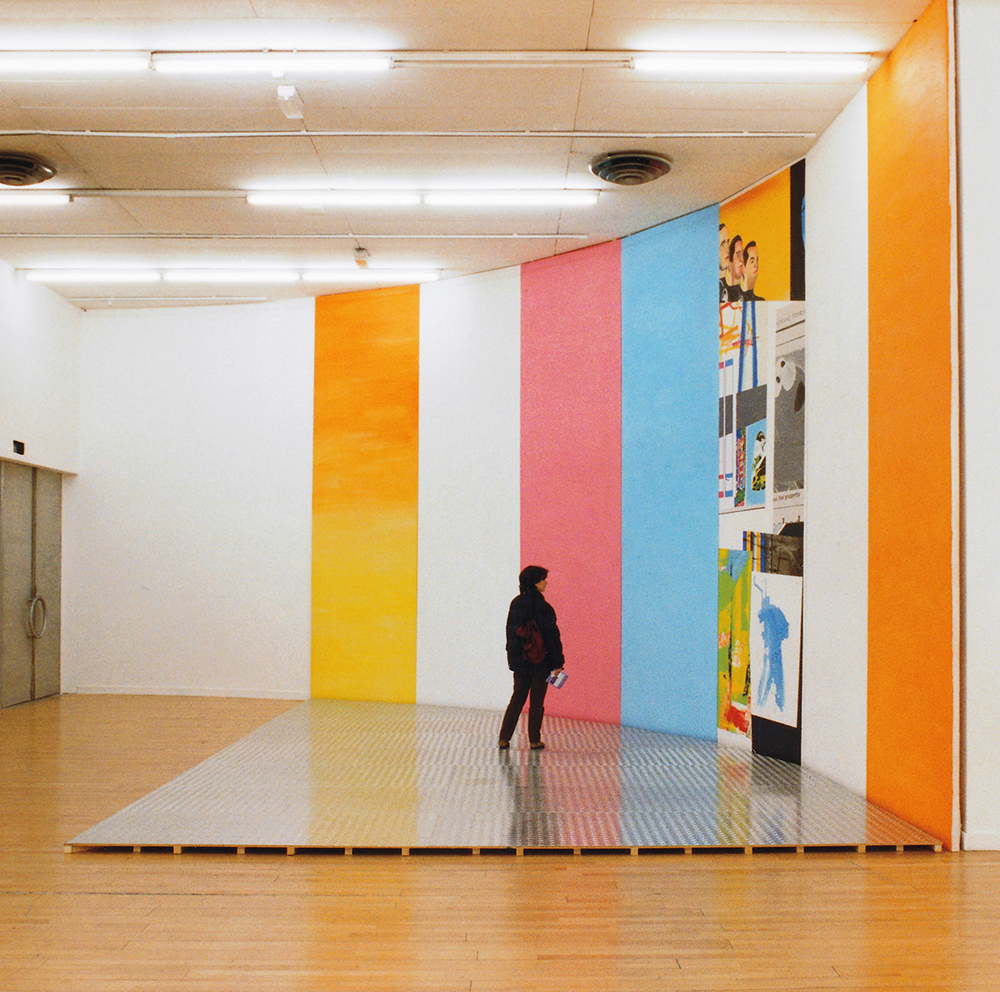PRESENTATION: Michel Majerus
 Throughout his short but prolific career, Michel Majerus captured the spirit of his time – decades marked by the expansion of globalised consumer culture and digital technology. His large-scale paintings and installations are characterised by the visual sampling and collage of an eclectic repertoire of imagery and text. Borrowing freely from art history, video games, advertising and electronic music, his work resonates with the frenzy of images and information that pervades contemporary society through the ubiquity of the internet.
Throughout his short but prolific career, Michel Majerus captured the spirit of his time – decades marked by the expansion of globalised consumer culture and digital technology. His large-scale paintings and installations are characterised by the visual sampling and collage of an eclectic repertoire of imagery and text. Borrowing freely from art history, video games, advertising and electronic music, his work resonates with the frenzy of images and information that pervades contemporary society through the ubiquity of the internet.
By Efi Michalarou
Photo: MUDAM Archive
Michel Majerus transgressed the rules of painting and reinterpreted the pop culture of the 1990s and early 2000s. He used these influences in a way that implied an engagement not only with broader cultural developments, but also with the parameters of artistic practice and reception in a way that is still relevant today. Majerus’s installations typically explored the growing role of the digital, allowing visitors to walk through and experience emerging visual cultures in an immersive way. “SINNMASCHINE” [Sense, or Meaning Machine] (1997), the departure point and entrance to the exhibition in Mudam, is one of these. Referencing “The Man-Machine” (1978), the iconic album by German electronic music band Kraftwerk. The installation “SINNMASCHINE”, first shown in 1998, impressively shows how Michel Majerus creates his own artistic spaces within exhibitions, transforming his work into an environment that visitors are invited to experience from ever-new perspectives. Seven canvases, each 4,9 metres high and 1,5 metres wide in the original, are arranged in a curve, enclosing a non-slip industrial metal floor. To experience the paintings up close, visitors can (or must) step on the floor. Instead of walking past works hanging on the wall at a customary distance, the viewers are directly confronted with the colored surfaces towering around them. The museum-like silence contrasts with the sounds that arise when walking on the shiny floor. As early as 1996, in a solo exhibition at Kunsthalle Basel, Majerus covered the elegant parquet floor in the central skylit hall with a steel grid floor that vibrated when walked on and made visitors’ footsteps audible. Two years earlier, at his first solo exhibition Majerus had an asphalt floor laid in the gallery, transforming the space into new terrain, complete with road markings. In the later gallery exhibition “sein lieblingsthema war sicherheit, seine these – es gibt sie nicht” (1999), the artist had a mirrored polystyrene floor laid, attached projecting elements to wall works, and divided the space with various fixtures, forcing visitors to pay constant attention to the interior architecture as they watched themselves walk through the exhibition. “SINNMASCHINE” also demonstrates other formal approaches that can be considered typical of Majerus: an interest in juxtaposing different materials, exploring large-scale colored surfaces and their effects, and quoting other sources. As is often the case, in “SINNMASCHINE” he references his own works in whole or in part, superimposing them like a collage on one of the seven panels. These are accompanied by references to pop culture and art history. A group portrait of the band Kraftwerk, as typically found on their covers, crowns partial reproductions of abstract paintings by Gerhard Richter and Willem de Kooning. This ‘picture strip,’ which stands out from the monochrome-colored surfaces of the other canvases, seems like a window into the artist’s working practice – a glimpse into the experiments he conducted in his studio and a glimpse of what results from them.
The early painting “Untitled” (1993) depicts a cartoonesque scene, deceivingly close to an illustration from a children’s book: a black kitten (a figure present in a number of Majerus’s works, such as Katze, painted the same year) playing in the snow with other small animals, all taking part in happy and innocent play. Another cat, appearing in a window frame in the background, recalls a character displayed on packaging from the German confectionary brand ‘Katjes’. A seemingly naïve text reads ‘maybe you should annihilate’. The meaning of these words, at odds with the apparent light-heartedness of the image and cheerful font, suggest the irony of the artist, while leaving his exact intentions open to interpretation. The monumental painting “running in cycles” (2001), is characteristic of Majerus’s affinity with large-scale canvases and installations. Featuring splashes of colors, a large ‘1’, circles and half-circles, and what recalls a deformed cycle track, running in cycles seems to be spinning in every direction. On the top-left, the words ‘fuck the artist’ echo the artist’s provocative reflections on authorship and the legacy of figures such as Joseph Beuys or Georg Baselitz, which appear in several of his paintings, as well as in the notebooks displayed in this exhibition. The inscription ‘burned ou[t]’, spread horizontally and bleeding outside the top-right corner of the canvas. The expression, today widely employed to define a state of physical and emotional exhaustion often linked to a work overload, could be tied to the bold statement ‘fuck the artist’, perhaps translating a disillusion regarding Majerus’s own condition as an artist. Although painted in the early days of the internet, the work seems prescient of the phenomenon of ‘burnout’ that has recently become widespread in societies ruled by capitalist incentives. The VHS displayed on the monitors in the exhibition space have been selected from the artist’s collection. Most of them are recordings Majerus made of various television programmes broadcasted on public channels such as Arte or RTL, or from channels dedicated to music and emblematic of the 1990s and early 2000s, such as MTV or VIVA. They reveal his fascination for mass media and pop culture, but also highlight the eclecticism of his interests, with programmes ranging from documentaries about artists or author filmmakers (Andy Warhol, Roy Liechtenstein, or Ingmar Bergman); a reportage on the Berlin neighbourhood of Prenzlauer Berg; Hollywood films (A Woman Under the Influence, by John Cassavetes); a large selection of pop, rock and rap music videoclips; and a Superman cartoon. While the internet has now arguably superseded television for the diffusion of information, these recordings are a reminder of the prominence of television and encapsulate the cultural spirit of the time.
Photo: Michel Majerus, running in cycles, 2001, Screen printing ink on PVC, © Michel Majerus Estate, 2023 Collection Mudam Luxembourg Acquisition 2002
Info: Curator: Bettina Steinbrügge, Assistant Curator: Clémentine Proby, Mudam Luxembourg-Musée d’Art Moderne Grand-Duc Jean, 3 Park Drai Eechelen, Luxembourg, Duration: 31/3-1/10/2023, Days & Hours: Mon & Thu-Sun 19:00-18:00, Wed 10:00-21:00, www.mudam.com/


